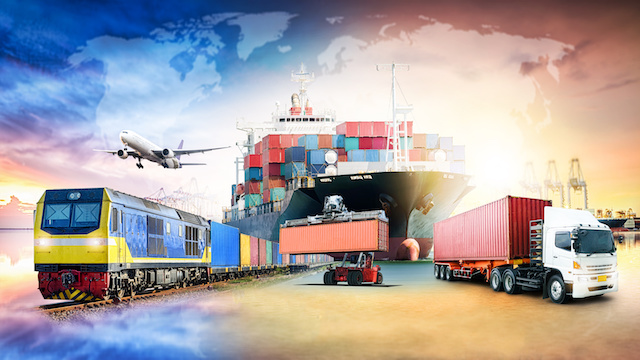 David Wells Chief Executive, Logistics UK
David Wells Chief Executive, Logistics UK

The logistics industry has experienced a period of unprecedented change in recent years with a host of challenges to face including the global Covid 19 pandemic, significant staff shortages and their impact on the way goods move in the economy, and the UK’s departure from the EU. Throughout 2021, media headlines focused on disruptions to the supply chain while, following COP26 in November, decarbonisation was highlighted on the world stage.
January 2021 was a particularly turbulent period for logistics as it adapted to a new post-Brexit trading environment, while also dealing with the ongoing Covid-19 pandemic. Customs formalities and other border requirements changed, resulting in the increased need for precise and accurate shipment data for every load moved. However, traffic flows at the crossing points between the UK and EU were never significantly disrupted by the new processes, which is a testament to the tremendous efforts made by industry and government on both sides of the Channel to ensure the new processes were implemented as effectively as possible and that traders and hauliers were fully prepared.
From July 2022, there will be further changes to trading arrangements between the UK and EU, with alterations to the requirements for Export Health Certificates, Safety and Security declarations on imports and Phytosanitary Certificates, as well as physical checks on SPS goods at Border Control Posts. The government previously delayed the introduction of these checks and requirements from their original start date, in a decision very much welcomed by the logistics industry, which had called for the extension to provide businesses with more time to prepare for the changes while attention was focused on keeping supply chains operating effectively during the pandemic. These are large scale changes and, once again, Logistics UK will continue to advise UK and EU traders and hauliers to follow government guidance on the new rules to ensure they are as prepared as possible for the coming changes, in order to keep disruption to a minimum.
As well as Brexit, Covid-19 has been a significant challenge for the industry. Maritime shipping faced disruption early into the pandemic, with many factories and ports across Asia forced to close as the virus spread, affecting all modes of the supply chain worldwide. Furthermore, passenger travel and air freight are linked intrinsically and with large amounts of cargo travelling in the bellyhold of passenger planes, the disruption of Covid-19 on air freight was inevitable. For example, flights into Heathrow accounted for around 60 per cent of UK air freight volume prior to the pandemic. While demand remained high, overall capacity for air cargo shrank by 25 per cent compared to 2019 levels as a result of the changes in traffic. Despite this, the air cargo industry continued to play a vital role throughout the peak of the pandemic, continuing to deliver the nation’s goods as well as vital medicines and PPE.
In September 2021 the easements of restrictions allowing passengers to return to travel were welcomed by the sector. While the emergence of the Omicron variant has since caused uncertainty across industry once again, the air sector remains resilient and with UK restrictions now easing once again, it is hoped that 2022 will be less turbulent.
While Covid-19 reduced the capacity for air cargo movements, it resulted in increased capacity for rail freight. Prior to the pandemic, the rail network operated at full capacity with passenger travel often prioritised. However, the number of passengers decreased significantly due to lockdowns, caution over using public transport and the increase in working from home, resulting in the total number of individual journeys made dropping by 51 million during Q4 of 2019-2020. As a result, thanks to the released capacity across the network, rail played a key role in ensuring the timely delivery of essential goods and the movement of PPE across the country.
An April 2021 report ‘Value of Rail Freight’ by the Rail Delivery Group showed that intermodal freight services on some underutilised off-peak passenger routes delivers greater economic value than passenger use and as passengers return to rail and the nation looks towards the long-term recovery of Covid-19, Logistics UK is urging government to ensure that access for freight remains a key consideration and to consider these report findings, which would allow freight operators continued access to these vital lines.
Covid-19 also impacted the road freight sector in a number of ways, including a dramatic increase in the number of home deliveries made (as consumers switched from in person to online retailing) and changes in the reallocation of road space to enable social distancing in urban areas, as well as acting as a contributing factor towards the HGV driver shortage. Due to Covid-19 safety rules, DVSA carried out around 45,000 fewer HGV driver tests than normal in 2020/2021. This, combined with a number of short-term and long-term factors such as Brexit and a poor industry image fuelled by issues such as poor driver facilities and lack of funded training opportunities, resulted in the industry’s ongoing skills shortage reaching a critical level during 2021.
Throughout this period, Logistics UK worked closely with members and launched an effective campaign for government action to reduce supply chain disruption. The business organisation was pleased to see government adopt many of our proposals including additional funding for driver training through Skills Bootcamps, a commitment to improving parking facilities, increased funding bands for driver Apprenticeships and the doubling of DVSA driver testing capacity to clear the backlog of individuals waiting to take their tests. While the position on HGV driver availability seems to be improving, the industry-wide skills shortage will continue to pose a challenge throughout 2022, not just for HGV drivers but across a number of roles such as warehouse staff and vehicle technicians.
Logistics UK will continue to raise awareness of the job opportunities available in the sector across the next 12 months. Most recently, the organisation has been engaging with Department for Education on skills training and has called for Level 2 Skills training to be added to the National Skills Fund, which it hopes to see in 2022. Logistics UK’s dedicated Skills Advice Hub has information for members on how to access training funds, how to use Apprenticeships, and job vacancies.
Another key opportunity for logistics is decarbonisation, with the national goal for net zero emissions set for 2050. In July 2021, the government released its Transport Decarbonisation Plan (TDP) outlining its strategy to decarbonise all modes of domestic transport by 2050. Acting as government’s ‘green print’ for a net zero industry, the plan encouraged a multimodal approach and reinforced the role each sector must play in decarbonising transport. And, while huge strides have already been taken across all sectors, more must be done in the coming years to ensure environmental targets are met.
In rail, despite only accounting for around one per cent of domestic GHG emissions by transport mode in 2019, the Department for Transport (DfT) has committed to delivering a net zero railway network by 2050 and announced ambitions to remove all diesel-only trains from the network by 2040. In recent years, DfT has completed almost 700 track miles of electrification across England and Wales and throughout 2022, we will see the government begin further decarbonisation programmes, such as electrification of the Trans-Pennine main line and Midland Main Line.
Rail supplies £30 billion of goods to customers across Britain each year – according to a 2018 report by the Rail Delivery Group – and with each freight train able to remove up to 76 HGVs off the UK’s roads, moving goods by rail, using diesel locomotives, saves 76% carbon per freight tonne mile compared to using road. Additionally, electric freight trains produce 60% less carbon emissions than diesel trains and their use could result in a 90% carbon saving per freight tonne mile, compared to road. Rail freight will continue to be a key focus for 2022, with the need to encourage a larger modal shift from road to rail at the core. It is vital that freight operators receive increased access to the railway network. The creation of Great British Railways – who will have a statutory duty to promote rail freight to secure economic, environmental and social benefits for the nation – will be central to this and Logistics UK looks forward to working with them throughout 2022.
The government has also committed to ‘kick-start’ commercialisation of UK Sustainable Aviation Fuel (SAF) – current United Nations timelines state that at least 10 per cent of fuel used in global aviation should be sustainable by 2030 – and to support the development of new and zero carbon UK aircraft technology. Logistics UK awaits eagerly these developments over the next 12 months.
Arguably the most significant decarbonisation progress is being made across the road sector. With the phase out date for the sale of new petrol and diesel vans set for 2030, and with more available models than ever before, many operators are making the transition to battery electric vehicles. The transition to net-zero vans is now underway with the number of electric fleets set to increase over the next twelve months. However, it is vital that the necessary charging infrastructure is in place to support operators making the switch, and Logistics UK will continue to focus on this moving forward.
The transition to zero emission HGVs is more complicated and uncertain, with no commercially viable options currently available for mass-market purchase – although several models are currently on trial or in production – and no decision made on the government’s preferred fuelling option. Announced in the TDP were trials to test and develop various technologies such as hydrogen and electric road systems. With the sale of new diesel and petrol HGVs to be banned in Britain by 2040, and with natural fleet replacement cycles to be considered, 2022 must be a transformative year, providing answers and reassurance for the sector so that the chosen options can be phased into vehicle renewal programmes. Logistics UK looks forward to seeing the progress of the trials and supporting in any way possible.
There is much progress to be made across maritime, with a detailed consultation on domestic measures set for 2022. This is expected to include research and innovation funding, measures to reduce ship emissions while at ports, and the prospect of a UK wide scheme to monitor and potentially reduce GHG emissions. A difficult sector to decarbonise, shippers will also be anticipating the announcement for the next international set of GHG regulations currently being negotiated at the UN agency for shipping, the International Maritime Organisation (IMO).
Logistics is an extremely complicated and fast paced industry. And while challenges such as operating during a global pandemic have affected the industry in the past two years, it is important to appreciate that the industry always adapts to overcome issues and meet the needs of the nation – and will continue to do so. The future of logistics is bright, and with so much unprecedented change happening, it is an exciting time to join the industry. Moving forwards, it is important the government provides certainty surrounding decarbonisation, and supports logistics as it looks towards long-term recovery from the pandemic. Logistics UK will continue to work with government, members and key industry figures to seek best possible outcomes for the sector charged with supplying the nation.
For further information visit logistics.org.uk